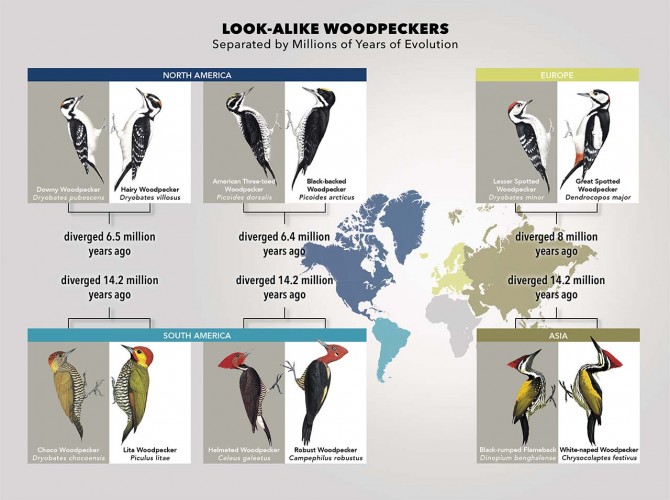Study: Some woodpeckers imitate a neighbor’s plumage
By Pat Leonard
Scientists have found evidence that some woodpeckers can evolve to look like another species of woodpecker that lives in the same area.
In the first global test of the idea, the researchers say that this “plumage mimicry” isn’t a fluke – it happens among pairs of distantly related woodpeckers all over the world. The study, published April 8 in the journal Nature Communications, was conducted by researchers at the Cornell Lab of Ornithology, Buffalo State College, the University of British Columbia and Manchester University.
“Habitat, climate and genetics play a huge role in the way feather color and pattern develop,” said lead author Eliot Miller, collections development manager at the Cornell Lab. “Species in similar environments can look similar to one another. But in some cases, there’s another factor influencing the remarkable resemblance between two woodpecker species and that’s mimicry. It’s the same phenomenon found in some butterflies, which have evolved markings that make them look like a different bad-tasting or toxic species in order to ward off predators.”
Study authors combined data on feather color, DNA sequences, eBird reports and NASA satellite measures of vegetation for all 230 of the world’s woodpecker species. It became clear, Miller said, that there have been repeated cases of distantly related woodpeckers that closely resemble each other when they live in the same region of the globe.
“In North America, the classic look-alike pairing is the downy woodpecker and the larger hairy woodpecker,” Miller says. “Our study suggests that these two species have evolved to look nearly identical above and beyond what would be expected based on their environment. Yet, these two species evolved millions of years apart.”
Other North American look-alikes are black-backed and three-toed woodpeckers. In Europe, greater and lesser spotted woodpeckers bear a striking resemblance, as do the lineated, robust and helmeted woodpeckers of South America.
Though not part of the study, Miller’s take on the reason for woodpecker doppelgangers is that downies that look like the larger, more aggressive hairy woodpeckers might make other birds, such as nuthatches and titmice, think twice about competing with them for food. Some evidence supporting this idea has been found in observational studies but field experiments would be needed to more conclusively test this hypothesis.
The data turned up other interesting connections between woodpecker appearance and habitat. Many of the woodpeckers the scientists looked at in tropical regions have darker feathers. This adds to a growing body of evidence in support of “Gloger’s Rule,” which states that organisms tend to be darker colored in more humid areas. They also found that:
- Red-headed woodpecker species tend to live in forested habitats;
- Black, white and gray colored species tend to live in open habitats;
- Woodpeckers with red on their bellies are most often found in forests; and
- Woodpeckers with large patches of color on their bellies were most often found in open habitats.
Additional studies would be needed to ferret out why some plumage patterns seem to be linked to habitat types.
“It’s really fascinating,” Miller said. “And it’s pretty likely this is happening in other bird families, too. I first got interested in this question a decade ago from looking through bird books. I wondered how the heck some distantly related species could look so much alike – what are the odds that it could happen just by chance?”
Pat Leonard is a staff writer at the Cornell Lab of Ornithology.
Media Contact
Get Cornell news delivered right to your inbox.
Subscribe

